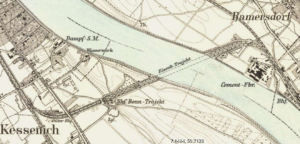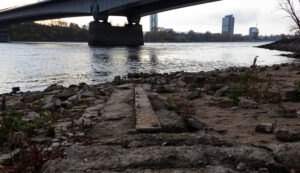Bonn’s Unique Ferry
Have you ever been on a ferry before? Many of us have, probably while driving or maybe as a pedestrian or bicyclist like while going to hike Drachenfels (link here) across the river from Bonn. But how about while riding a train? Probably not, but while researching for my final paper I stumbled across a Wikipedia page about the Bonn–Oberkassel train ferry.

The Bonn–Oberkassel train ferry linked the two sides of the Rhine River in Bonn, Germany. It operated from 1870 to 1919 being the last of six train ferries to operate on the Rhine River and the second to last to cease operation. Managed by the Rhenish Railway Company or Rheinische Eisenbahngesellschaft in German, it connected the left and right Rhine railways, facilitating direct rail traffic between the two banks at a time when permanent bridges were limited.

The ferry system employed paddle steamers equipped with tracks, enabling entire trains to be transported across the river. Guided by wire cables, the ferries operated at a 45° angle to the river’s current, ensuring stability and efficiency during crossings. The total length of the ferry route was approximately 5.9 km, with the river crossing itself spanning about 550 meters taking 20 minutes to cross. On the Bonn side, the ferry station was situated near the riverbank, connecting to the main railway line near Kessenich and eventually integrating with Bonn Hauptbahnhof, the central station.
The ferry service ceased operations in January 1919 and was quickly destroyed, with the structures on each side of the river being replaced by a train yard on the Bonn side and a shipyard on the Oberkassel side. This was a culmination of reasons stemming from the ferry’s closure during much of World War One, improvement in bridge crossing across the Rhine, the desire to remove the wire used for the ferry allowing other boats easier transit, and the increasing rail usage exceeding the ferry’s capacity.

Today, remnants of the Bonn–Oberkassel train ferry along the Rhine, most visible during low water levels, serve as historical markers of a bygone era and an interesting part of Bonn and the greater Rhineland’s railroad history and relationship with the Rhine.
-Bram H.
References:
Hans Schlieper: Eisenbahntrajekte über Rhein und Bodensee. Alba Verlag, Düsseldorf, 2009, ISBN 978-3-87094-369-1.
Klaus Kemp: Das Trajekt Bonn-Oberkassel. In: VdEF-Mitteilungen. Nr. 9, 1973, ZDB-ID 1157927-4.; Ders.: Das Trajekt Bonn-Oberkassel. In: Bonner Geschichtsblätter. Jahrbuch des Bonner Heimat- und Geschichtsvereins, ISSN 0068-0052, Band 35, Bonn 1984, S. 187–214.
Rheinische Eisenbahn-Gesellschaft: Bericht über die Resultate der Verwaltung, des Baues und des Betriebes der Rheinischen Eisenbahn. 1862–1874, ZDB-ID 611463-5.
Rheinische Eisenbahn-Gesellschaft: Geschäfts-Berichte. 1875–1882, ZDB-ID 611464-7 und ZDB-ID 611465-9.
